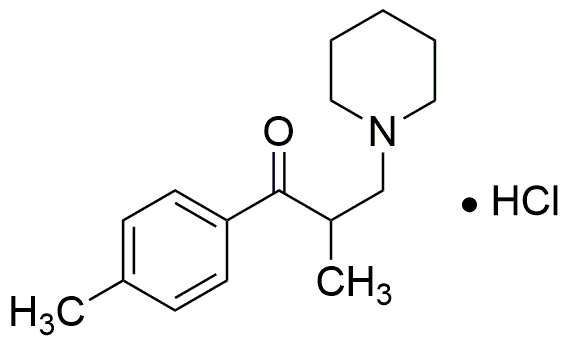Tolperisone hydrochloride is widely utilized in research focused on:
- Muscle Relaxation: Primarily used as a muscle relaxant, it helps alleviate muscle spasms and discomfort, making it valuable in rehabilitation settings.
- Neurological Research: Its effects on the central nervous system are studied for potential applications in treating conditions like multiple sclerosis and spinal cord injuries.
- Pharmaceutical Development: Used in the formulation of medications aimed at pain relief, it assists pharmaceutical companies in developing effective pain management therapies.
- Veterinary Medicine: Applied in veterinary practices to treat muscle spasms in animals, providing a solution for pet owners and veterinarians alike.
- Clinical Trials: Frequently involved in clinical studies assessing its efficacy and safety, contributing to advancements in medical treatments and patient care.
Informations générales
Propriétés
Sécurité et réglementation
Applications
Tolperisone hydrochloride is widely utilized in research focused on:
- Muscle Relaxation: Primarily used as a muscle relaxant, it helps alleviate muscle spasms and discomfort, making it valuable in rehabilitation settings.
- Neurological Research: Its effects on the central nervous system are studied for potential applications in treating conditions like multiple sclerosis and spinal cord injuries.
- Pharmaceutical Development: Used in the formulation of medications aimed at pain relief, it assists pharmaceutical companies in developing effective pain management therapies.
- Veterinary Medicine: Applied in veterinary practices to treat muscle spasms in animals, providing a solution for pet owners and veterinarians alike.
- Clinical Trials: Frequently involved in clinical studies assessing its efficacy and safety, contributing to advancements in medical treatments and patient care.
Documents
Fiches de données de sécurité (FDS)
La FDS fournit des informations de sécurité complètes sur la manipulation, le stockage et l’élimination du produit.
Spécifications du produit (PS)
Le PS fournit une description complète des propriétés du produit, notamment sa composition chimique, son état physique, sa pureté et les exigences de stockage. Il détaille également les plages de qualité acceptables et les applications prévues du produit.
Certificats d'analyse (COA)
Recherchez des certificats d'analyse (COA) en saisissant le numéro de lot du produit. Les numéros de lot et de lot se trouvent sur l'étiquette d'un produit, après les mots « Lot » ou « Lot de fabrication ».
Numéro de catalogue
Numéro de lot/série
Certificats d'origine (COO)
Ce certificat d'exploitation confirme le pays dans lequel le produit a été fabriqué, et détaille également les matériaux et composants utilisés et s'il est issu de sources naturelles, synthétiques ou autres sources spécifiques. Ce certificat peut être requis pour les douanes, le commerce et la conformité réglementaire.
Numéro de catalogue
Numéro de lot/série
Fiches de données de sécurité (FDS)
La FDS fournit des informations de sécurité complètes sur la manipulation, le stockage et l’élimination du produit.
DownloadSpécifications du produit (PS)
Le PS fournit une description complète des propriétés du produit, notamment sa composition chimique, son état physique, sa pureté et les exigences de stockage. Il détaille également les plages de qualité acceptables et les applications prévues du produit.
DownloadCertificats d'analyse (COA)
Recherchez des certificats d'analyse (COA) en saisissant le numéro de lot du produit. Les numéros de lot et de lot se trouvent sur l'étiquette d'un produit, après les mots « Lot » ou « Lot de fabrication ».
Numéro de catalogue
Numéro de lot/série
Certificats d'origine (COO)
Ce certificat d'exploitation confirme le pays dans lequel le produit a été fabriqué, et détaille également les matériaux et composants utilisés et s'il est issu de sources naturelles, synthétiques ou autres sources spécifiques. Ce certificat peut être requis pour les douanes, le commerce et la conformité réglementaire.


